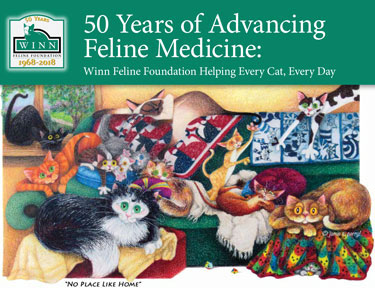Winn Feline Foundation: 50 years of advancing medicine
Feline medicine has come a long way in the past half-century, thanks in part to the Winn Feline Foundation.

2018 is the foundation's 50th anniversary. Since 1968, Winn has provided more than $6 million for feline health research.
Kicking off a yearlong celebration, Winn marked Oct. 21, 2017, as the inaugural Cures4Cats Day during the American Association of Feline Practitioners' conference in Denver. Dr. Margie Scherk spoke about the long history of domestic cats and relatively short history of feline medicine, and the foundation released the book "50 Years of Advancing Feline Medicine: Winn Feline Foundation Helping Every Cat, Every Day."
In 1968, the Cat Fanciers Association started what was then the CFA Foundation with a $100 donation. In 1971, the foundation was renamed after the late Robert H. Winn, who had been the association's attorney and an original member of the foundation's board. In 1978, the foundation held its first annual symposium on feline health.
According to the anniversary book, funding from Winn Feline Foundation has contributed to the following developments:

- 1987 The discovery that most cases of dilated cardiomyopathy in cats are related to taurine-deficient diets, leading to reformulated standards for all commercial cat foods.
- Identification of the feline immunodeficiency virus.
- 1988 Demonstration that blood pressure can easily be measured in cats with the correct cuff sizes.
- 1989 Determination of the inheritance pattern of feline blood groups and the mechanism of neonatal isoerythrolysis, making it possible to avoid fading kitten syndrome.
- 1995 A study of kittens altered at 7 weeks of age compared with kittens altered at 7 months of age, providing evidence that earlier spay and neuter surgery is safe and feasible.
- 2000 Confirmation that tablets or capsules given to cats may remain in the esophagus for more than five minutes, unless a drink of water or a small treat is given afterward.
- 2003 Demonstration of the effectiveness of a high-protein, low-carbohydrate diet to treat diabetic cats.
- 2004 Identification of a genetic trait associated with feline polycystic kidney disease.
- Confirmation of the efficacy of medication delivered to cats in metered dose inhalers, improving the treatment of feline asthma.
- Identification of the genetic mutation that causes feline hypertrophic cardiomyopathy in Maine Coon cats.
- 2007 Identification of the genetic mutation that causes feline hypertrophic cardiomyopathy in Ragdoll cats.
- Identification of the mutations in red blood cells that cause A and B blood groups.
- An analysis of genetic data from more than 1,100 cats indicating that the Mediterranean was the site of cat domestication and that the genetic diversity of cats remains broad around the world.
- 2012 Identification of the genetic mutation that causes hypokalemia in Burmese cats.
- Development of best practices for treating ringworm in infected cats and disinfectant protocols.
- 2013 Discovery of a mutation that allows the feline infectious peritonitis virus to bind to and enter cells.
- 2014 Development of a protocol for using mesenchymal stem cells derived from a cat's own fat to treat feline chronic gingivostomatitis.
- 2015 Identification of the genetic mutation that causes spasticity in Devon Rex and Sphynx cats.
- 2016 Beginning of a clinical trial of a drug to treat feline infectious peritonitis.
- Identification of the genetic mutation responsible for a craniofacial defect in Burmese cats.
- Exploration of safer and more effective drugs for Tritrichomonas foetus infection.
- 2017 A report on the transdermal application of an appetite stimulant, mirtazapine, in cats.
The anniversary book is available to download for free or to order for the cost of shipping at winnfelinefoundation.org/50th-anniversary-book.